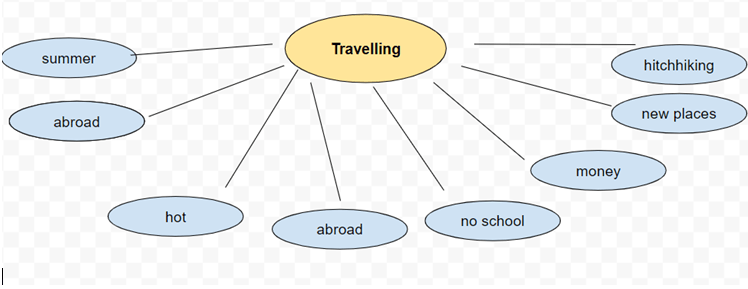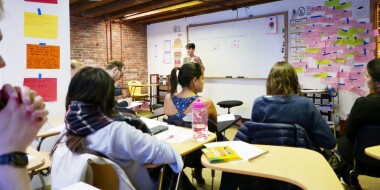As you may know, CELTA is among the most popular options when it comes to a teacher’s PDP (professional development plan). In my experience, it’s a great course if you are looking for an insight into teaching English as a foreign language.
CELTA equips you with the tools and knowledge necessary to take your first steps into the teaching community or polish your skills if you already have experience in teaching. This course helps you learn how to work structurally and meet the needs of your students as best as possible.
Here I will be talking about 3 aspects of teaching reading, listening and writing skills in accordance with CELTA guidelines.
Experienced teachers with good English skills are always welcome at Skyeng! Pre-made lesson plans designed with your student’s needs in mind, higher pay, ongoing tech support and more.
Contents:
1. Reading exercises
Passive skills usually get less attention in the production-centred classroom. To make up for that, here I’d like to share some reading activities that I have learnt to use during the CELTA course I was doing a couple of years ago.
Stage 1 — Warming up
First of all, we should bear in mind that no matter what skill we are working with (speaking, writing, listening or reading) warming the students up for the upcoming session is the first step to take. This ensures that the learners familiarise themselves with the topic and are ready to dive into it at later stages of the lesson.
For example, let’s say we need to create a context for a reading section about travelling.
Draw a spider diagram and ask the students to brainstorm the associations they have with the word “travelling”. Elicit at least 8 ideas. Below is a sample of a spidergram my students had come up with.

Next you can ask the students to comment on 3 questions about travelling in pairs.
• Tell me about an adventure you had while travelling.
• Where would you like to travel to next and why?
This will also get the students warmed up for the topic and will let them have speaking practice right in the beginning of the class.
Stage 2 — Setting the context
Setting up the context is a vital part of lesson delivery if you want your students to have the bigger picture of the class and see the lesson outcomes. This stage makes sure the students are on the same page during the sessions and don’t get distracted.
Present one paragraph of the text (I usually take the first one), ask the students to read it, work in pairs and come up with ideas of what the text is going to be about. This ignites their interest and makes them competitive in coming up with the story closest to the original.
If the story has characters, places, events, take them out of the context and have the students recreate the story.
Put the students in pairs and have them come up with possible stories. It will surprise you how many stories the students come up with, sometimes better than the original one.
When students are ready, read their stories out (let them read it themselves, or maybe pass around) to make sure everyone knows what the other teams’ stories were.
Stage 3 — Reading for gist
At this stage, the primary goal for the students is to compare the original story to the one they had come up with. Make sure to point out that they don’t need to worry about the unknown words. What matters is the general idea of the text.
This is what I normally do.
Break the text into 2 parts and put them on different slides of a PowerPoint presentation. Next, split the students into pairs and have them sit back to back, so that one of the students sees the slide and the other doesn’t.
Time the student who sees the slide for 2–4 minutes, depending on the length of the text, and have him/her read it. Then ask the students to change seats and give the other student an equal amount of time to read the text on the second slide.
When done, ask the students to face each other and tell their parts to each other, trying to put the story together.
If the text is not that long, you can always go with the traditional “Read the text and comment on the following questions” task. I strongly recommend looking through those questions carefully before the class and adapting them to your learners’ level.
It’s a good idea to have the students work in pairs or groups where they can help each other understand and find the answers to some questions together. It will ease some pressure on the slower learners.
Stage 4 — Vocabulary Work and Reading for Details
This is the vocabulary pre-teaching stage where we focus on the new words. Have a look for some nice ideas here.
Once we have introduced the words that might be new to our students, it’s safe to move on to the next stage of teaching reading skills. At this stage, students go deeper into the text, trying to learn more information, focusing on details and reading between the lines (for B2+ and higher level learners).
You can find a traditional True or False exercise in all the ESL/EFL books. To make it more fun, turn the T/F statements into open-ended questions. This will give the students a chance to generate more language while answering the questions.
You can even create questions which have more than one possible answer. In this case, you will also have your students speculating on the possible answers and have more speaking practice.
Once the students are done reading the text, you can turn it into a gap-fill exercise where they will need to fill in the missing information.
This doesn’t have to be with the exact wording of the text (unless your focus is to work on the target language in the text). You can simply ask the students to fill in the gaps in a logical way that will not contradict the meaning of the text and will be lexically/grammatically correct.
It’s a marvellous opportunity for the students to work not only with a simple task of gap filling, but also deal with sentence structures, synonyms, antonyms, etc.
Stage 5 — Controlled practice
This is the stage where students need to practise the language/structure of the text. Normally, this stage is used to work on the target language presented at an earlier stage of the lesson.
If there is more than one character in the text, take them out, assign the students to act out the roles of those characters and recreate the text by making a dialogue. Make sure that the students are using the language from the text. You can either put it on the board or ask them to highlight it in the text. Alternatively, you can ask students to retell the story on behalf of some characters.
Another interesting activity can be conducting an interview. You will need to split the students in pairs and assign them the roles of an interviewer and the author or a character from the story. The interviewer will need to ask their interviewee different questions and keep the conversation going.
Stage 6 — Fluency Practice
This final stage is to make sure the students can use the knowledge gained in real life situations. As we know, reading texts mostly serves to introduce vocabulary or grammar in ESL/EFL books. So, there are several activities you can do to give your students some nice practice.
Put your students in pairs or groups (depending on your class size) and distribute some questions related to the topic of the lesson (“travelling” in our case). Ask the students to interview each other with those questions using the target vocabulary/grammar.
• ESL Discussions: Conversation Questions: Speaking Lesson: TRAVEL
• Travel Conversation Questions
• EFL/ESL Conversation Questions about Travel I LingoTies
You can ask the students to write a text similar to the one they had just read using the language and structure presented in the text. In this case, the reading session can easily turn into a writing one. Later on, you can ask the students to pass the stories around, read them and vote for the best one.
Read as well:
2. Listening exercises
CELTA stresses the importance of paying due attention to all the language skills as they form the language on the whole. This includes such receptive skills as listening. Here is a lesson structure I used during my CELTA course.
Stage 1 — Presentation
Again, it’s important to start by setting context for the lesson. The PPP approach (presentation, practice, production) works the best for me.
Use pictures to introduce the participants of the conversation. Here are some sample pictures that you can use to elicit what the listening is going to be about.

Present the following questions for the students to brainstorm:
• What do you think are their names?
• How do you think they are feeling? Why?
• How do you think their conversation will end?
This will allow your students to get into the topic of the lesson, generate a lot of language on the situation and feel more involved while already listening to the track.
You can provide some sample language from the dialogue to make the students’ job easier. Another idea is to print the script of the conversation, remove some parts of it and give it to the students to read, act out and fill in the missing information.
Once the students finish brainstorming, elicit their stories and encourage them to listen and check whose story was closer to the original one. This is the second stage, the so-called “Listening for gist”, where students need to listen for general information without focusing on the details.
Next step is the presentation of the language. Here, you will need to identify the language that can be new to your students and elicit the meaning, form, and pronunciation.
Teaching pronunciation and sentence stress is of utmost importance when teaching listening skills. Students can have a lot of trouble understanding the speech if they are unaware of the silent letters, the stress patterns, how the words connect to each other in speech, etc.
“Wʊdjə laɪk səm ˈkɔːfi” ↗ — this is what you hear.
Stage 2 — Practice
At this point, the students have covered the target language and are more or less aware of the context of the listening. We can proceed with the “Listening for details” step of the lesson.
This stage is also known as “Controlled practice”. Here, you can ask the students to:
• Listen again and comment on open-ended questions.
• Listen again and fill in the gaps.
• Listen again and order the dialogue, etc.
This step helps the students understand the audio in more detail and be ready to speculate on it. In cases when the students are still having some doubts, it’s a good idea to listen to it one more time.
This brings us to the next step, where the students will need to practise the language and the situational context they were working with before. Ask the students to:
• Act out the dialogue from script or memory and change the ending.
• Add some information when acting out the dialogue.
This step prepares the students for the next stage.
Stage 3 — Production
The end result of your work comes into play. If students manage to produce the language they have covered during the previous stages to create a situation of their own and manipulate with the language, then it’s a success.
I personally ask my students to create a situation of their own, using the target language. They are free to write it down, act it out in pairs and then present it to the whole class.
3. Writing exercises
These writing activities are quite intuitive and well structured. Including them in your lessons will help better envision the end result and the learning goal for your audience.
Stage 1 — Lead-in
Lead-in should help students get more insights into the topic at hand, generate interest, create some associations to better compile with the tasks later on.
Ask the students what short stories they’ve read. Post the titles on the board. Alternatively, pick a short story that is very well known among your target audience. Ask the build-up questions below:
• What was the most interesting part for you?
• What would you change in the story if you could?
• Was there a problem/conflict in the story? What was it?
• How was the problem solved?
This will also get the students to think about the key points of writing a story.
Stage 2 — Model text
It’s an optional activity you can use if you have enough classroom time. Simply print the story without any paragraphs. Next, ask the students to come up with the structure of the story.
Stage 3 — Language work
At this point, students are working on the language that can help them create the stories using specific phrases to sound more sophisticated, fluent and cohesive.
You can use the model text to do this. Asking the students to highlight the linkers and fillers used in the text. This will help them get acquainted with the language they’ll be asked to use in the text.
You can decide to develop language out of context by giving them an exercise containing the target language.
1. While / During the summer we travelled around seven European countries.
2. I moved house last week. During / at that time the previous few months I’d been living with my parents.
3. While / During I was waiting for you, I finished my book.
4. I stopped smoking three years ago and I haven’t had a single cigarette from that point on / an hour later.
5. It was the late 1950s, and from that point on / at that time there weren’t any supermarkets in England.
6. As soon as / During I find time I will call you.
7. We missed our flight, and as soon as / from that point on, things just got worse.
8. Giovanni used to look after the children while / at that time Clara was at work.
Adapted from Total English Upper-Intermediate Student’s Book p. 36,
Workbook p. 21 by; Richard Acklam, Araminta, Pearson, Longman
Stage 4 — Content preparation
Here students speculate on what the story is going to be about.
Set the students in pairs, give them the title of the story, the names of the main characters, and the place the events will be taking place. Students then need to come up with a storyline. This is the easiest one as there is little to no preparation time for the teacher and it leaves the students to their imagination.
Prepare a set of pictures you want the students to be working with. Set them in groups and ask to think about what the story will be about. They can draft ideas as to the main stages of the story, the names of the characters, etc.

Stage 5 — Writing
It’s when students actually start writing down the stories they’ve come up with at the stage of brainstorming. It’s best to set students in pairs to work, as it will be easier and more interesting. You might want to choose the weaker student as a writer to have them also participate in the creation of the text. Otherwise, the strong student will take over.
Stage 6 — Feedback
There are two feedback stages: feedback on content and feedback on language.
CELTA teaches us that feedback on content should always come first. It’s vital for the students to see whether they have achieved the task and how relevant the text is. Start with positive feedback to prepare your group for constructive criticism later on.
Once this is done, you can follow up with feedback on language. Focus on the common mistakes in general and discuss them with the class. Individual mistakes can be discussed privately with the students or set as homework to save face.
If you choose to try these activities in your classroom, let me know how it went!








 Мария Цедрик
Мария Цедрик 
 Галина Смирнова
Галина Смирнова 
 Юлия Белоног
Юлия Белоног
amazing
1) I will use the option where I read one paragraph and the student one and try to explain each oher